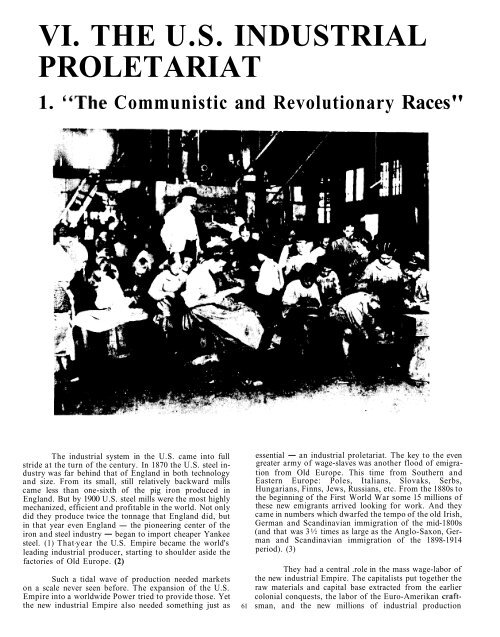sakaisettlersocr
sakaisettlersocr
sakaisettlersocr
Create successful ePaper yourself
Turn your PDF publications into a flip-book with our unique Google optimized e-Paper software.
VI. THE U.S. INDUSTRIAL<br />
PROLETARIAT<br />
1. "The Communistic and Revolutionary Races"<br />
The industrial system in the U.S. came into full<br />
stride at the turn of the century. In 1870 the U.S. steel industry<br />
was far behind that of England in both technology<br />
and size. From its small, still relatively backward mills<br />
came less than one-sixth of the pig iron produced in<br />
England. But by 1900 U.S. steel mills were the most highly<br />
mechanized, efficient and profitable in the world. Not only<br />
did they produce twice the tonnage that England did, but<br />
in that year even England - the pioneering center of the<br />
iron and steel industry - began to import cheaper Yankee<br />
steel. (1) That-year the U.S. Empire became the world's<br />
leading industrial producer, starting to shoulder aside the<br />
factories of Old Europe. (2)<br />
Such a tidal wave of production needed markets<br />
on a scale never seen before. The expansion of the U.S.<br />
Empire into a worldwide Power tried to provide those. Yet<br />
the new industrial Empire also needed something just as<br />
essential - an industrial proletariat. The key to the even<br />
greater army of wage-slaves was another flood of emigration<br />
from Old Europe. This time from Southern and<br />
Eastern Europe: Poles, Italians, Slovaks, Serbs,<br />
Hungarians, Finns, Jews, Russians, etc. From the 1880s to<br />
the beginning of the First World War some 15 millions of<br />
these new emigrants arrived looking for work. And they<br />
came in numbers which dwarfed the tempo of the old Irish,<br />
German and Scandinavian immigration of the mid-1800s<br />
(and that was 3 M times as large as the Anglo-Saxon, German<br />
and Scandinavian immigration of the 1898-1914<br />
period). (3)<br />
They had a central .role in the mass wage-labor of<br />
the new industrial Empire. The capitalists put together the<br />
raw materials and capital base extracted from the earlier<br />
colonial conquests, the labor of the Euro-Amerikan craft-<br />
61 sman, and the new millions of industrial production


